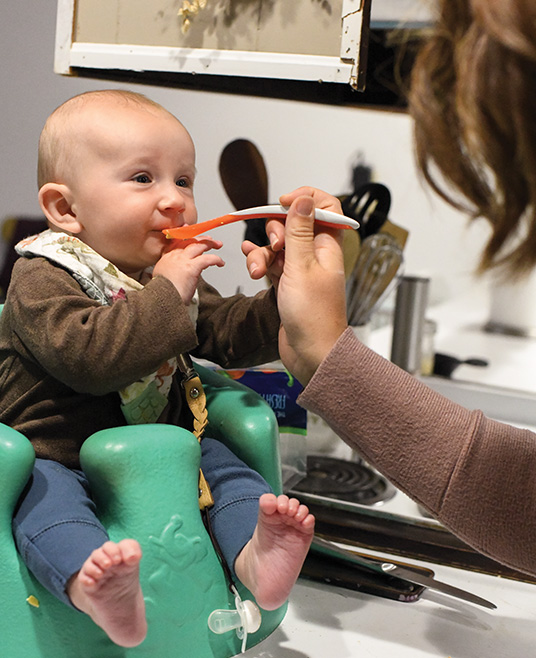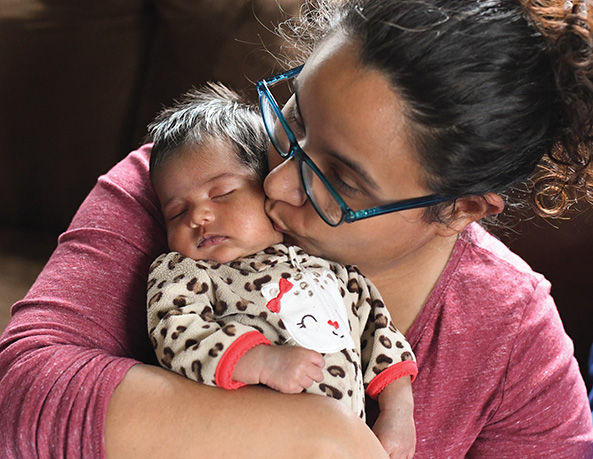
Hello Vawlei
Kei cu na naute ka si. Nang cu ka zeizongte na si.
Pum in, lungthin in, le khuaruahnak in thawng ngai in ka than khawhnak hnga zangfahnak in ka bawm. Hitin na ka tuah tikah ka than bik:
- Takvun i ton in ka tlai asiloah ka kuh. Na kut chungah ka hna a ngam.
- Mirh law bia ka ruah. Na sin in tampi ka cawn.
- Bia kan “ruah” tikah ka ngai piak. Ka paw a tam tikah, ka khim tikah, ka sia a rem lo tikah, asiloah ka bat tikah ka pum cawlnak le aw hmang in bia kan chimh.
Minung hnuk asiloah thirdat aa telmi baby formula (hngakchia rawl) cu ka thannak dingcaah a hmasa bik thla 6 tiang ka herhmi asi.
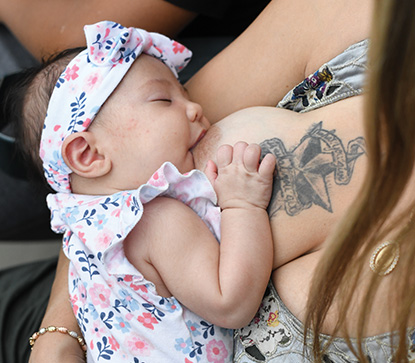
Hnukdinhnak
Nangmah Nih Ka Thannak Dingcaah A Herhmi Na Ngei.
- Dam tein le zawt loin ka umnak ding a bawmtu caah ka herhmi thazang umnak a zapi in a um.
- Ka than bantuk in na minung hnuk zong aa thleng ve. Hnuk sau deuh kan dinh ah, a tha chinchin ve.
Formula Peknak
Formula ka din ahcun, aa tel dingmi pawl hman tein cawh dingcu abiapi tukmi asi. Dur i a ummi cawhnak lamhmuhsaknak pawl cu zulh hna.
Thol ah ti cu cawh hmasa ta law, cun powder formula asi lai.
Formula dur i telhchihmi suahnak cu hman peng hna. A level ningin asi ko timi tha tein zoh hna.
Timhciami bawhte formula cu timh hnu in suimilam 2 chungah hman hna. Timh hnu suimilam 2 ah hman asi lo ahcun, refrigerator (kihternak bizu) ah fim hna law suimilam 24 chungah hman hna.
Ka ei le cang ka in, suimilam 1 hnu ah thol ah a tangmi formula cu holh hna.
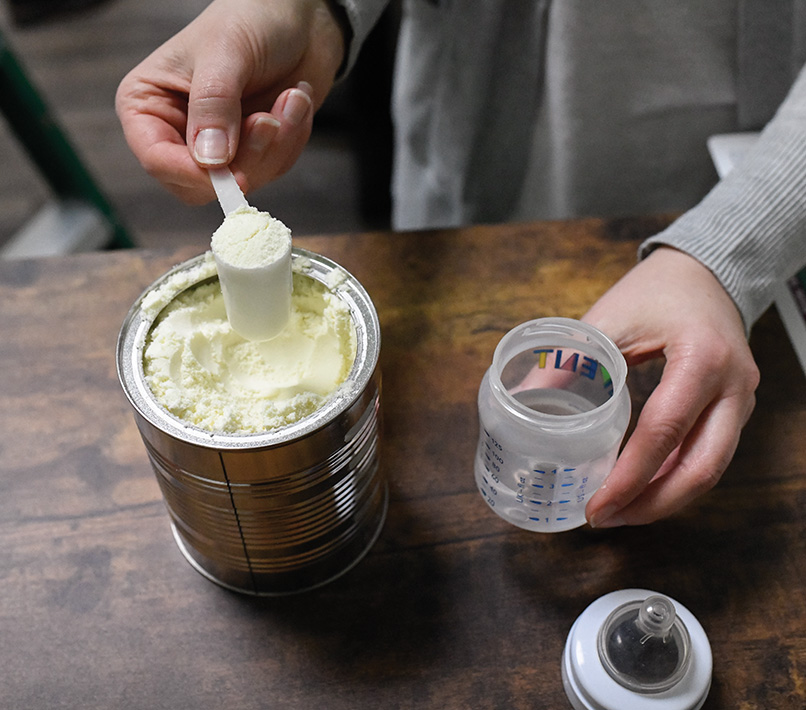
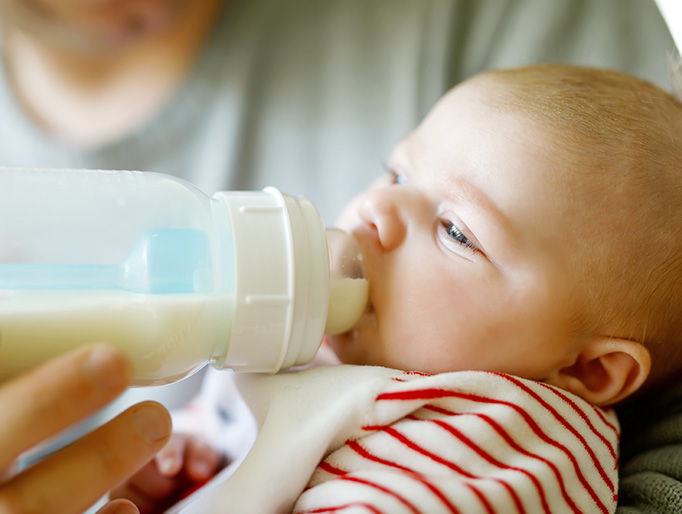
Duhsah in Thol in Einak
- Voikhat ah tlawmte lawngin pek hram ka thawk hna, minung hnuk asiloah formula 2 in 3 ounce lawng asi lai.
- Thol in zeitluk ran in dah ka din timi cu rii ka khiah piak.
- Ka khim tikah theih dingcu ka zum ko. Thol pakhat cu ka dih ter dih hlah.
- Pek dingin timhcia na si hlan tiang refrigerator ah timhciami thol cu fim hna law suimilam 24 chungah hman hna.
- Minung hnuk asiloah formula cu microwave in lum hlah. “A Lin” mi nih ka kaa a ka kangh khawh. Ouch! Ka thol cu a lummi ti a tang ah lum ter deuh hna.
Na Ka Tongh Ka Herh
Na ka ei ter lio ah ka tlai.
Nangmah he cun ka hna a ngam i na hmai zoh ka duh.
Atu le Atu Ei Lengmang ka herh
Ka paw cu a hme.
Ka paw cu voikhat ah 2 in 3 ounce tluk lawng aa tlum.
Suimilam 24 chungah voi 8 in 12 tiang ei ka duh lai.
Suimilam 1½ in 3 fatinte ka ei ter peng.
Ka paw cu voikhat ah 4 in 6 ounce tluk lawng aa tlum.
Suimilam 24 chungah voi 6 in 8 tiang ei ka duh lai.
Naute vialte an i dang dih hna timi theih hna. Nikhat le nikhat cu azat i khat loin ka ei men lai. Ka upa deuh i ka paw a than caah, a caan tlawm deuh in ka ei men lai, asinain ka ei fatin tam deuh in ka ei kho lai.
Ka Hmelchunhnak Ngiat Hna
Ka herhmi theih ter dingcaah ka pum cawlcanghnak le aw ka hmang hna. Hi hmelchunhnak pawl na ngiat ahcun, ka tap hlan ah na ka leh khawh lai. Ka ngam tikah rawl pek ka fawi deuh tuk lai.
“Ka Paw A Tam”
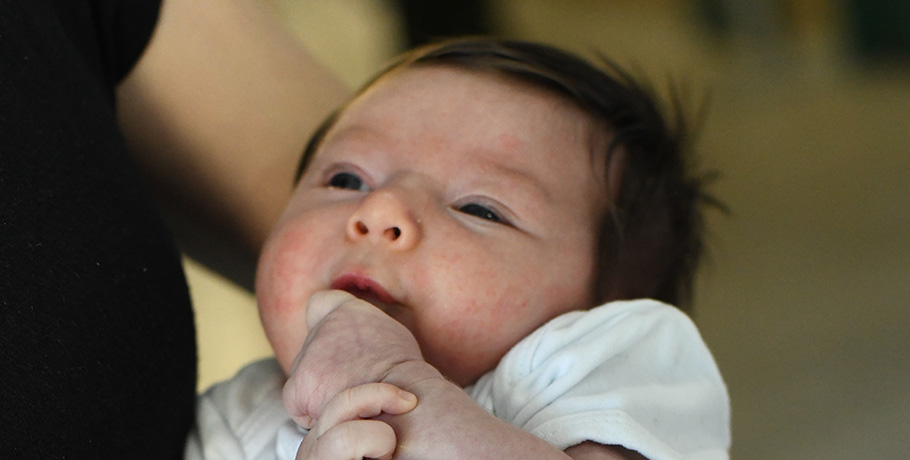
Ka paw tam hram aa thawk tikah, hitin ka um men lai:
- Ka kut cu ka kaa ah asiloah ka kaa pawngah ka chiah lai
- Ka kut le ke ka cawl lai
- Hnuk a dawpmi aw ka chuah lai
- Ka kaa asiloah ka lei ka cawl lai
- Ka lu ka mer lai asiloah hnukhmur (a hram) ka kawl lai
“Ka Paw A Khim”
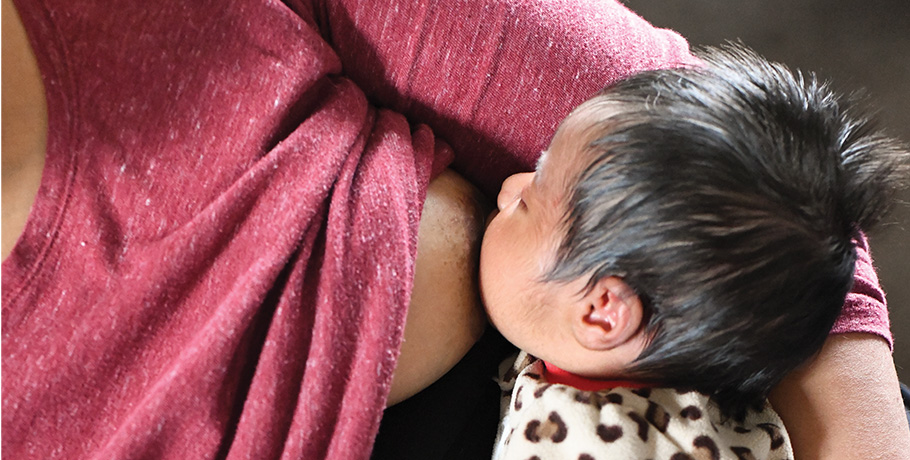
Ka paw a khim tikah, hitin ka um men lai:
- Huam sam deuh in ka dawp asiloah dawp ka ngol
- Kut le ban dai ter
- Hnukhmur mer tak
- Ka nam
- Kaa hngilh
- Na ka ei ter rih ahcun, hmaisur in, zia tam ngeih in, asiloah chuih in ka um lai
Thannak Caan (Growth Spurts)
Kan than caah, ka caan sauimi cu aa thleng men lai, cun caan dang nak in tam deuh in ei le it ka duh men lai. Hihi cu thannak caan tiin an auh.
Naute cu an i dan dih hna, asinain thannak caan cu a tanglei kum ah hin a chuak men lai:

2 to 3 weeks
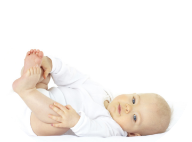
4 to 6 weeks

3 months
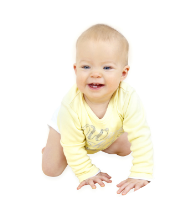
4 months
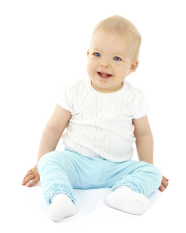
6 months
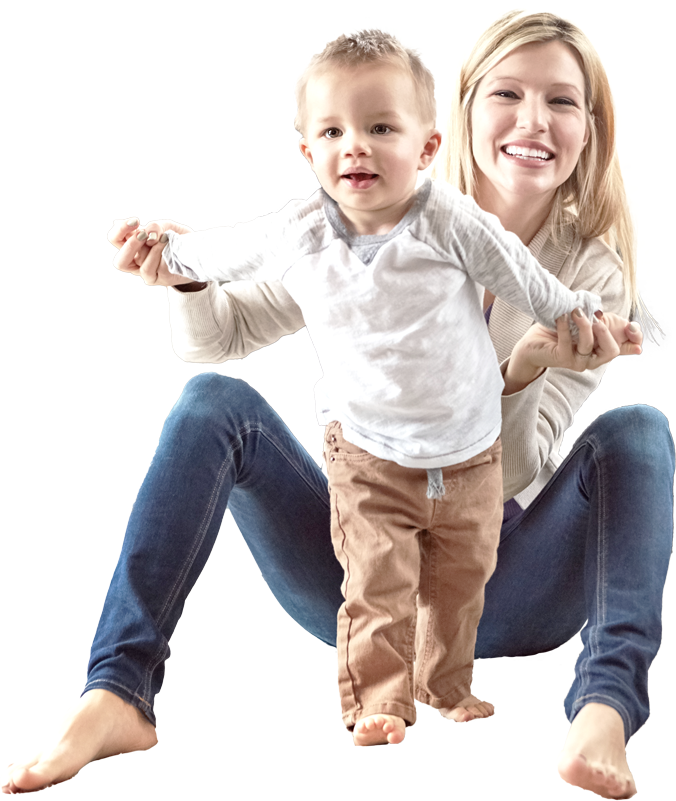
9 months
Na pum zongnih ka herhmi a theih lai i ka thannak caan he tlak tein hnuk tam deuh in a chuah ter lai. Hnuk na dinh deuhdeuh ah asiloah na sur deuhdeuh ah, na hnuk tam deuh a chuak ve lai.
Ka ei hnu in ka paw a tam bantuk in ka um than ahcun, hnuk ka pe than. Thol khat ka din ahcun, adang 1 ounce asiloah 2 ounce in ka pe than.
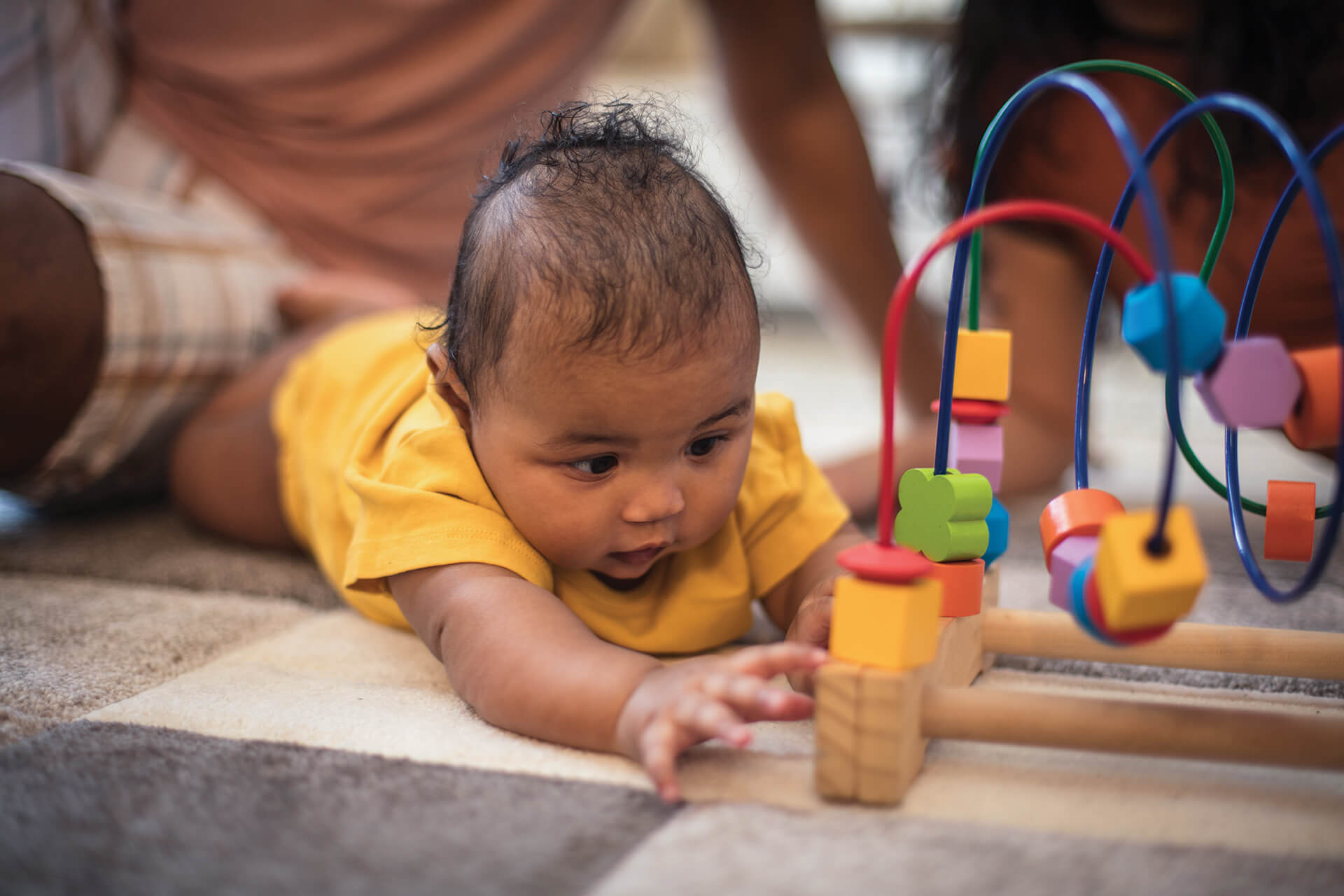
Play with me!
I’m ready to learn about you, me, and the world we live in. I want to discover what my body can do. Give me TUMMY TIME when we play. When I’m alert and relaxed, put me on a blanket on the floor. Watch how I stretch and kick my legs and move my arms. I’m making them stronger.PLAYING helps me learn, improve coordination, build strength, explore, and bond with you!

Keimah he lente i celh!
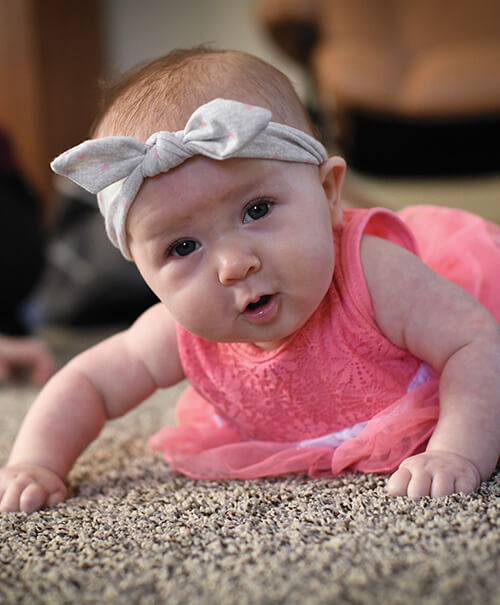
Nangmah, keimah, le kan umnak vawlei kong cawn dingin timh cia ka si cang.
Ka pum nih zeidah a tuah khawh timi kawlhawl ka duh.
Lente kan i celh lio ah BAWKNAK CAAN ka pek.
Kaa hliphlau i ngam tein ka um caan ah, zeltuang cung puan phahmi cungah ka chiah. Ka ke zeitindah ka samh i ka chuih timi le ka ban ka cawlmi ka zoh hna. Thawng deuh hna seh tiah ka tuahmi hna asi.
- LENTE CELHNAK nih cawn a ka bawmh, tangtinak a thangcho ter, thazang a sem ter, hlethlainak le nangmah he tlaihchanhnak kha asi ter!
Zeidah ka tuah khawh timi zoh hmanh!
Kaa nuam lio, dawt ka si lio, le hnangam lio ah a tha bik in ka cawn.
Ka caah vawlei cu a thar asi. Tih a nung kho mi asi. A hram thawk ahcun ka tap tuk men lai.
- Tahnak cu kan herh timi chimhnak ding a lam pakhat asi.
- Vun i tongh in kan um tikah, ka hna a ngam. Na ka zohkhenh ko timi ka theih.
- Na ka tlaihmi nih a ka hrawh lai lo.
- Hramthawk ahcun kaa hngilh lai, kaa thang lai i ka ei lai, cun ka it than peng lai. Cucu punghman asi ko i than a ka bawmh.
- Thla 3 ka si tikah, caan sau deuh piin kaa hngilh men lai.
- Ka cawn lio asi caah zangfahnak in na lung sau ko seh.
Na aw ka theih.
- Bia na chimmi ngai cu ka duh tuk.
Caan suaimi ningin um hram kaa thawk.
- Zaan ah sau deuh kaa hngilh kho lai.
Thawng deuh le hliphlau deuh in ka than lio asi.
- Ka lu ka cawi kho.
- Ka min na chim tikah ka theih.
- Ba-ba-ba tiin fiang loin ka chim lai!
- Ka ni kho.
- Peek-a-boo le pat-a-cake timi i celh usih.
Zangfahnak in ca ka rel piak.
- Hmanthlak ka hmuhsak hna law zeidah an si timi ka chim hna.
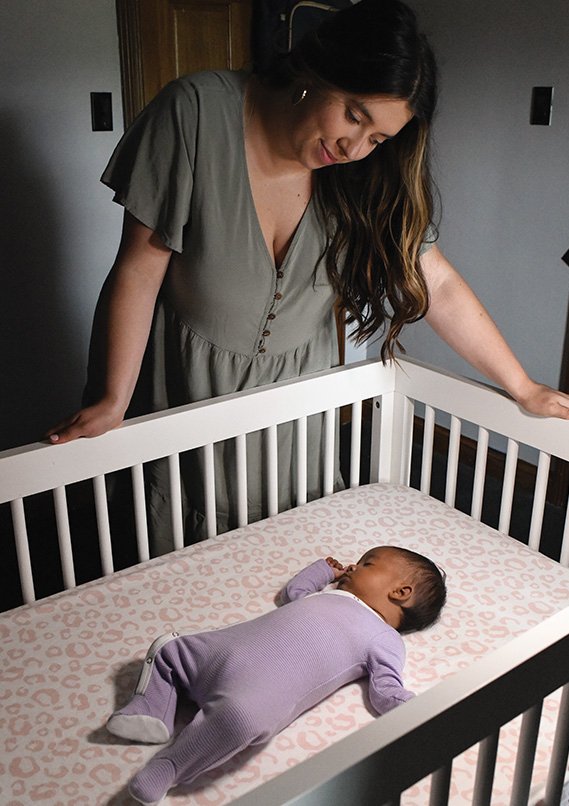
Him tein le Ngandam tein Ka Chiah
- It dingcaah keimah lawng in ka keng lei in, le ka nau thlimnak bawm ah asiloah pack-n-play (nau thlimnak bawm) ah ka chiah PENG. Khaan cu kan i hrawm khawh, asinain ihnak pakhat cu kan i hrawm kho lo. Puan, chantling, asiloah tunu nih ka kaa asiloah ka hnar a khuh ahcun ka thaw a pit kho mi asi.
- Ka rawl na ser hlan le na ka pek hlan ah na kut i tawl hmasa hna.
- Ka ei hnu in, ka kaa cu a thiangmi, a nemmi, a cinmi puan in, a bik in ka ih hlan ah ka hnawt hna.
- A hakmi rawl na ka pek hlan ah thla 6 ka si tiang hngak ta. Ka zawt khamnak (immune) system cu than ter dingcaah le rawl tha tein ei in ka dolh khawhnak hnga ka kaa chung i taksa cu thawn ter dingcaah caan ka herh. Timhcia ka si hlan ah a hakmi rawl pek ka si ahcun, kaa hak kho asiloah ka zaw kho.
- Kan chungkhar ngandam tein le him tein a umnak hnga sahdah asiloah khuhsi in sermi thil pawl, zu, sii hnah carmi, le adang phung a lut lomi sii hna cu hrial hna. Sahdah asiloah khuhsi in sermi thil pawl tonhtilonak ding bawmhnak caah www.quitnow.net ah hin rak zoh hna. Zu asiloah adang si pawl tonhtilonak ding bawmhnak caah www.findtreatment.gov ah hin rak zoh hna. Na Special Supplemental Nutrition Program for Women, Infants and Children (WIC, Nu, Bawhte le Hngakchia caah Pum Thazang Umnak Lei A Bawmtu Special Program) Thazang umnak eidin tirawl lei thiamsang nih adang a herhmi thil hna zong an pek khawh rih.
DON’T let me have these foods until I am at least 1 year old:
Cow’s milk or other non-dairy milks (like soy or almond milk). It’s too hard for me to digest and may cause health problems.
Honey and foods made with honey. Honey can contain bacteria that cause infant botulism, or food poisoning. These bacteria are harmless to older kids and adults.
Introducing Peanut Butter
If my healthcare provider says it is ok, let me try peanut butter around 6 months of age. Doing this might help prevent a peanut allergy as I grow older.
In the morning, mix one teaspoon of peanut butter with human milk or formula. Make it thin and easy to swallow.
Use a spoon to offer a taste of the thinned product. Wait 10 minutes, then offer more. Watch for any reaction for the next 2 hours.
